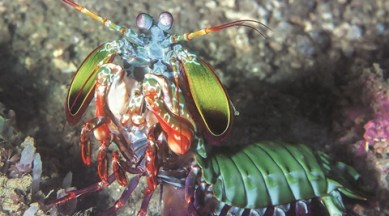📣 For more lifestyle news, click here to join our WhatsApp Channel and also follow us on Instagram
Neither Here, Nor There: Mantis shrimp are shy, family-minded creatures
Neither mantis nor shrimp, this shallow water inhabitant of tropical and semi-tropical marine waters has been around for 450 million years or more and are related to crabs and lobsters.

It’s a world many of us, including myself, have largely missed out on: the kaleidoscopic, shimmering rainbow world beneath the sea, whether in the sun-spangled shallows of coral reefs or the mysterious ultra-indigo depths 20,000 leagues beneath. They are populated by a multitude of nature’s most bizarre and dazzling cast of characters, many of which are still completely alien to us.
One such weirdo is the mantis shrimp. Neither mantis nor shrimp, this shallow water inhabitant of tropical and semi-tropical marine waters has been around for 450 million years or more and are related to crabs and lobsters. There are more than 450 species, ranging in size from around 10 cm to 46 cm and many are clad in the carnival colours of clowns. But these are clowns of a different hue — they’re true badass clowns. There are two main branches of the clan: the spearers and the smashers, depending on the armament they carry. The former have spiny appendages at the ends of their raptorial claws which grow out of the sides of their mouths — well barbed — rather like the arms of a praying mantis, with which they impale and hook their prey, usually soft-bodied creatures like fish. The latter has a hard club-ended appendage with which it punches its victim at the speed of a 0.22 calibre bullet leaving the barrel of a gun. If that were not enough, the force of the blow causes air bubbles (called cavitation bubbles) to boil around the club and when these quickly collapse, they let loose a powerful shock wave (accompanied by a tiny flash of light and sound) that further bludgeons the victim. (The collapse of cavitation bubbles in other situations has caused holes to be punched in the propellers of boats). Try moving a fist as fast as you can under water, and you’ll appreciate the effort needed to deliver a punch of any magnitude. These guys ambush or chase down hard-shelled fellows like crabs and rock oysters, smashing them open with the force of their blows.
To develop these magnum forces, their specialised limbs consist of a system of springs and latches powered by muscles; one muscle compresses the spring, another latches it in place and the third (like a trigger) releases the latch — and wham, the arm zings out!
For all their ferocity, they are shy, family-minded creatures: in some monogamous species, partners may stay together for as many as 20 years and both may bring up their families. So much so, that in one species, the female lays two clutches of eggs: his and hers! They’re shy and spend most of their lives in their burrows or tunnels at the bottom, only emerging to hunt or maybe socialise a bit. They have dust-ups among themselves, but punch each other more with the intent of sending the opponent head over heels than smashing it to smithereens (They also have padded posteriors which they hold up to their opponents to cushion blows).
Apart from their sucker punches, mantis shrimps have the most astonishing eyes of any creature under or above water. Our eyes have three colour receptors, sensitive to green, blue and red light. Our brains process inputs coming from these and signal what colour we’re actually seeing. Using just these three receptors, we can distinguish colours and shades.
Mantis shrimp have 12 colour receptors, so you would imagine they would be able to distinguish thousands of colour shades more than us. But here’s the thing — to their surprise, scientists discovered that they cannot do this and that we were, in fact, better at distinguishing close colours and shades. Further, of these 12 colour receptors, five or six were attuned to ultraviolet wavelengths (which, we cannot see), of which several were actually filtered out because they could be harmful. So how come the mantis shrimp is worse than us in telling, say scarlet from orange? With us, much of our colour analysis is done by our brains, which process raw information sent by our red, blue and green receptors and inform us exactly what shade we’re seeing. With the mantis shrimp (which lacks our brainpower), it seems that the colour receptors simply short-circuit the system and recognise the colour wavelength they’re attuned to straight away: the “red” receptors recognise the colour red and don’t fuss about whether it’s scarlet or orange. This information is enough to instantly tell the mantis shrimp whether the creature it is looking at is a predator, prey or potential partner and how it needs to react; in its environment, milliseconds can mean the difference between life and death.
Scientists have also discovered that these astonishing creatures are able to “roar” or rumble, much like the long distant low frequency rumblings of elephants. What messages they send and receive and what they mean as yet remains a mystery of the deep. But, yes I fear, we have been warned!
Ranjit Lal is an author, environmentalist and birdwatcher
📣 For more lifestyle news, click here to join our WhatsApp Channel and also follow us on Instagram